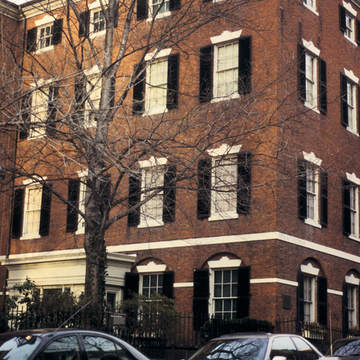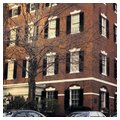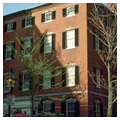East of his own south-facing mansion (1800, now demolished), Jonathan Mason built four handsome brick town houses with first-floor segmental arches as investments and as future homes for his daughters. Numbers 55 and 57 faced west onto Mason's garden and the thirty-foot setback established by Charles Bulfinch's plan for the Mount Vernon Proprietors. The final two Mason houses (53 and 51 Mount Vernon Street) followed the line of adjacent town houses built by Stephen Higginson Jr. (BH23). Number 55 (NHL) is the most important survivor of this group, both because it has been little changed and because it is open to the public as a museum established by Rose Standish Nichols, an accomplished writer, landscape architect, and community activist who lived here until 1960. Number 57 also originally faced west, overlooking the garden of Mason's mansion; in 1837, a house rose on that land requiring housewright Cornelius Coolidge to move the entrance for number 57 to an extended southern facade. Daniel Webster lived here in 1817–1819 and Charles Francis Adams from 1842 to 1886.
You are here
Jonathan Mason Houses
If SAH Archipedia has been useful to you, please consider supporting it.
SAH Archipedia tells the story of the United States through its buildings, landscapes, and cities. This freely available resource empowers the public with authoritative knowledge that deepens their understanding and appreciation of the built environment. But the Society of Architectural Historians, which created SAH Archipedia with University of Virginia Press, needs your support to maintain the high-caliber research, writing, photography, cartography, editing, design, and programming that make SAH Archipedia a trusted online resource available to all who value the history of place, heritage tourism, and learning.


















